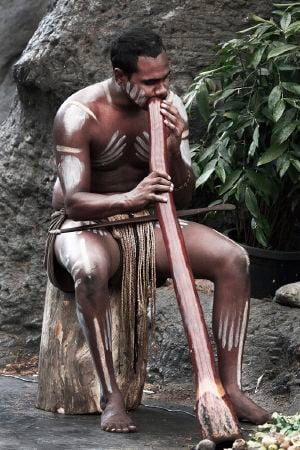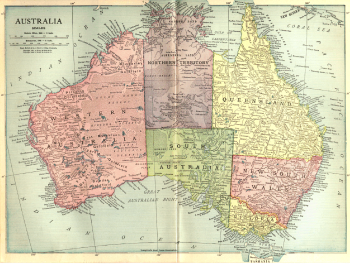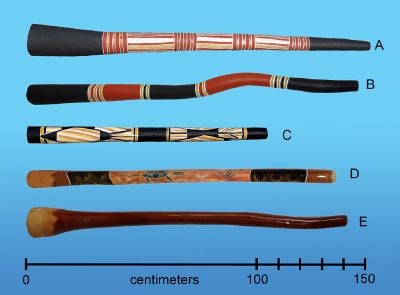Didgeridoo
The didgeridoo (also known as a didjeridu or didge) is a wind instrument of the Indigenous Australians (or aboriginal Australians) of northern Australia. Sometimes described as a natural wooden trumpet or "drone pipe," musicologists classify it as an aerophone. In fact, the didgeridoo has been studied in depth both by musicologists and ethnomusicologists (anthropologists that study the way cultures utilize music). A didgeridoo is usually cylindrical or conical in shape and can measure anywhere between 1 m (3.3 ft) to 3 m (9.8 ft) in length with most instruments measuring around 1.2 m (3.9 ft). Generally, the longer the instrument, the lower the pitch or key of the instrument. Keys from D to F♯ are the preferred pitch of traditional Aboriginal players.
There are no reliable sources stating the didgeridoo's exact age, though it is commonly claimed to be the world's oldest wind instrument. Archaeological studies of rock art in northern Australia suggests that the Aboriginal people of the Kakadu region of the Northern Territory have been using the didgeridoo for about 1500 years. The didgeridoo, thus, is a testament to the long-standing creativity and musical artistry of humankind.
Etymology
"Didgeridoo" is considered to be an onomatopoetic word of Western invention, rather than a traditional name that was used by the aboriginal people to refer to the instrument. The term didgeridoo is attributed to Herbert Basedow in 1925.[1] The earliest occurrences of the word in print include a 1919 issue of Smith's Weekly, where it was referred to as an "infernal didjerry" which "produced but one sound—didjerry, didjerry, didjerry and so on ad infinitum." There are numerous names for this instrument among the Aboriginal people of northern Australia, with yirdaki being one of the better known words in modern Western society. Yirdaki, also sometimes spelled yidaki, refers to the specific type of instrument made and used by the Yolngu people of north-east Arnhem Land. Many believe that it is a matter of etiquette to reserve tribal names for authentically produced tribal instruments, though on many occasions retailers and businesses have been quick to exploit these special names for generic, tourist-oriented instruments.
Regional Names for the Didgeridoo
There are at least 45 different synonyms for the didgeridoo. The following are some of the regional names.[2]
- Yolngu of Arnhem Land: Yirdaki
- Gupapuygu of Arnhem Land: Yiraka
- Djinang of Arnhem Land: Yirtakki
- Pintupi of Central Australia: Paampu
- Groote Eylandt: Ngarrriralkpwina
- Cobourg Peninsula: Wuyimba or buyigi
- Katherine: Artawirr
- Kakadu: Garnbak
- Mornington Island: Djibolu
- Roebourne, WA: Kurmur
- Kimberleys WA: Ngaribi
- Adelaide River: Bambu
- Alligator River: Martba
- Alice Springs: Ilpirra
History
The didgeridoo is perhaps the oldest wind instrument in the world. Some argue that the didgeridoo has been in use for over 40,000 years, but the oldest verifiable records (in the form of rock and cave paintings) of Aborigines playing the instrument puts the date closer to 1500 years ago.[1] Until the early twentieth century, the didgeridoo had a limited distribution in Australia, known only in the eastern Kimberley and northern portion of the Northern Territories. However, the strengthening of trade infrastructure (in the form of roads, missions, and other improvements in the transportation system) helped spread the art of making and playing the didgeridoo across most parts of Australia.
The first audio recordings of the didgeridoo were made in 1912 by Sir Baldwin Spencer. Didgeridoos were also mentioned in various ethnographies aimed at studying aboriginal peoples—in particular work done by Donald Thompson on the Yolngu and R.M. and C.H. Berndt in Arnhem Land. In 1953, the Tribal Music of Australia record, the first commercially available recording of the didgeridoo, recorded in the field by A.P. Elkin in Arnhem Land, was released by Folkway Records. This was later followed by The Art of the Didgeridoo by Trevor A. Jones in 1963, marking the first time that the traditional Aboriginal playing techniques of the didgeridoo were performed by a non-Aboriginal person.[1]
The 1960s also marked a time of specific, ethnomusicological research, conducted by Alice M. Moyle and Trevor A. Jones, who later published many articles on aboriginal music and the didgeridoo in particular.[1] That said, the instrument has seen a history of only a few decades in the west, and less than that with the tradition aboriginal style.
Construction
Authentic Aboriginal didgeridoos are produced in traditionally-oriented communities in northern Australia and are usually made from hardwoods, especially the various eucalyptus species that are native to the region. Sometimes a local bamboo or pandanus is used instead. Generally the main trunk of the tree is harvested, though a substantial branch may be used instead. Even when the main trunk is used, the tree will still regenerate as eucalyptus trees sprout again even when cut close to the ground.
Aboriginal didgeridoo craftsmen spend considerable time in the challenging search for a tree that has been hollowed out—by termites—to just the right degree. If the hollow is too big or too small, it will make a poor quality instrument. Termites attack living eucalyptus trees, removing only the dead heartwood of the tree, as the living sapwood contains a chemical that repels the insects. When a suitable tree is found, it is cut down and cleaned out. The bark is taken off, the ends trimmed, and some shaping of the exterior then results in a finished instrument. This instrument may be painted or left undecorated. A rim of beeswax may be applied to the mouthpiece end. Traditional instruments made by Aboriginal craftsmen in Arnhem Land are sometimes fitted with a "sugarbag" wax mouthpiece. This comes from wild bees and is black in appearance, with a distinctive aroma.
Less authentic didgeridoos can also be made from PVC piping. These generally have a 3.81 centimeters (1.50 in) to 5.08 centimeters (2.00 in) inside diameter, and have a length corresponding to the desired key. The mouthpiece may be made of the traditional beeswax, or a few layers of duct tape. An appropriately sized rubber stopper with a hole cut into it also can serve as a mouthpiece. Some have also found that finely sanding and buffing the end of the pipe creates a sufficient mouthpiece.
Playing the didgeridoo
The didgeridoo is played by continuously vibrating the lips to produce a drone while using a special breathing technique called circular breathing. This requires breathing in through the nose while simultaneously expelling air out of the mouth using the tongue and cheeks. By use of this technique, a skilled player can replenish the air in their lungs without having to stop play, effectively sustaining a note for as long as desired. Recordings exist of modern didgeridoo players playing continuously for more than 40 minutes.
Fellow of the British Society Anthony Baines wrote that the didjeridoo functions "…as an aural kaleidoscope of timbres" and that "the extremely difficult virtuoso techniques developed by expert performers find no parallel elsewhere."[3]
The coastal Aboriginal groups of northern Australia have developed the most sophisticated and technically refined of all playing styles. Groote Eylandt in northeast Arnhem Land and Western Arnhem Land, has been known to produce the finest didgeridoo players in the world. In these areas, compositions are rhythmically complex and multi-dimensional, with extraordinary techniques.
These Aboriginal Australians provide inspiration to didgeridoo players around the world.
Physics and operation
A termite-bored didgeridoo has an irregular shape that, overall, usually increases in diameter towards the lower end. This shape means that its resonances occur at frequencies that are not harmonically spaced in frequency. This contrasts with the harmonic spacing of the resonances in a cylindrical plastic pipe, whose resonant frequencies fall in the ratio 1:3:5 and so on. The second resonance of a didgeridoo (the note sounded by overblowing) is usually around an 11th higher than the fundamental frequency (a frequency ratio somewhat less than 3:1).
The vibration produced by the player's lips has harmonics, that is, it has frequency components falling exactly in the ratio 1:2:3 etc. However, the non-harmonic spacing of the instrument's resonances means that the harmonics of the fundamental note are not systematically assisted by instrument resonances, as is usually the case for Western wind instruments (for example, in a clarinet, the 1st, 3rd, and 5th harmonics of the reed are assisted by resonances of the bore, at least for notes in the low range).
Sufficiently strong resonances of the vocal tract can strongly influence the timbre of the instrument. At some frequencies, whose values depend on the position of the player's tongue, resonances of the vocal tract inhibit the oscillatory flow of air into the instrument. Bands of frequencies that are, thus, not inhibited from producing formants in the output sound. These formants, and especially their variation during the inhalation and exhalation phases of circular breathing, give the instrument its readily recognizable sound.
Other variations in the didgeridoo's sound can be made with "screeches." Most of the "screeches" are related to sounds emitted by Australian animals, such as the dingo or the kookaburra. To produce these "screeches," the player simply has to cry into the didgeridoo while continuing to blow air through it. The results range from very high-pitched sounds to much lower, guttural vibrations.
Cultural significance
The didgeridoo is sometimes played as a solo instrument for recreational purposes, though more usually it accompanies dancing and singing in ceremonial rituals. For Aboriginal groups of northern Australia, the didgeridoo is an integral part of ceremonial life, as it accompanies singers and dancers in religious rituals. Pair sticks, sometimes called clapsticks or bilma, establish the beat for the songs during ceremonies. The rhythm of the didgeridoo and the beat of the clapsticks are precise, and these patterns have been handed down for many generations. Only men play the didgeridoo and sing during ceremonial occasions, whilst both men and women may dance. The taboo against women playing the instrument is not absolute; female Aboriginal didgeridoo players did exist, although their playing generally took place in an informal context and was not specifically encouraged.
The didgeridoo was also used as a means of communication across far distances. Some of the sound waves from the instrument can be perceived through the ground or heard in an echo. Each player usually has his own base rhythm which enables others to identify the source of the message. These secondary uses of the instrument have ceased in modern times, with the advent of modern technology.
There are sacred and even secret versions of the didgeridoo in Aboriginal communities in parts of Arnhem Land, Northern Territory, and the surrounding areas. These sorts of instruments have specific names and functions and some of these are played like typical didgeridoos, whereas others are not. Due to their secluded nature, little is known about them.
Modern innovations
In the twentieth century, several "modernized" versions of the didgeridoo have been developed. The didjeribone (also called "slideridoo" or "slidgeridoo"), a sliding didgeridoo made of plastic, was invented in the second half of the twentieth century by Australian didgeridoo player Charlie McMahon.[4] It is constructed of two lengths of plastic tube, one of which is slightly narrower in diameter than the other, and which slides inside the wider tube in the manner of a slide trombone (hence the instrument's name). This allows players to achieve fundamental tones within the compass of a major sixth, ranging from low B♭ to high G.
The didgeridoo has also found a place in modern Celtic music. It can be seen played side by side with a set of Great Highland Bagpipes, in groups such as The Wicked Tinkers and Brother.
A keyed didgeridoo (having keys somewhat like those of a saxophone, allowing the performer to play melodically) was developed in the late twentieth century by the U.S. didgeridoo player Graham Wiggins (stage name Dr. Didg) and used on his albums Out of the Woods (1995) (on the track "Sun Tan") and Dust Devils (2002) (on the tracks "T'Boli" and "Sub-Aqua"). Wiggins built the unique and somewhat unwieldy instrument at the physics workshop of Oxford University, from which he earlier obtained his Ph.D.
In 1996, the Aboriginal Australia Art & Culture Centre of Alice Springs created the world's first online interactive didgeridoo "university" and was featured by Bill Gates when he launched Windows 98.[5]
The didgeridoo also became a role playing instrument in the experimental and avant-garde music scene. Industrial music bands like Test Department and Militia generated sounds from this instrument and used them in their industrial performances, linking ecology to industry, influenced by ethnic music and culture.
New foundation
Set up in mid-2008 the Australian Didge Foundation is a charitable foundation that raises money and awareness for Aboriginals wishing to learn the didgeridoo. Money would be raised and used to buy didgeridoos for those who can't afford them.
Health benefits
In addition to being prominent culturally to the aboriginal Australian, didgeridoos may also have been good for their health. A 2005 study in the British Medical Journal found that learning and practicing the didgeridoo helped reduce snoring and sleep apnea, as well as daytime sleepiness. This appears to work by strengthening muscles in the upper airway, thus reducing their tendency to collapse during sleep.[6]
Notes
- ↑ 1.0 1.1 1.2 1.3 Didgeridoo History: History and Timeline, IDIDJ Australia. Retrieved September 21, 2022.
- ↑ The Didgeridoo and Aboriginal Culture Aboriginal Australian Art and Culture Center of Alice Springs. Retrieved September 21, 2022.
- ↑ Anthony Baines, The Oxford Companion to Musical Instruments (Oxford: Oxford University Press, 1992, ISBN 9780193113343).
- ↑ Didgeribone Charlie McMahan Spirit Gallery. Retrieved September 21, 2022.
- ↑ Learning to Play the Didgeridoo Aboriginal Australian Art and Culture Center of Alice Springs. Retrieved September 21, 2022.
- ↑ Milo A. Puhan, Alex Suarez, et al., Didgeridoo playing as alternative treatment for obstructive sleep apnoea syndrome: Randomised controlled trial, BMJ (British Medical Journal) 332 (2006):266–270. Retrieved September 21, 2022.
ReferencesISBN links support NWE through referral fees
- Aboriginal Art and Culture Centre. Living history information: Aboriginal art & culture of Central Australia. Alice Springs, NT: Pwerte Martne Martne Aboriginal Corporation, 1997. OCLC 224580862
- Baines, Anthony. The Oxford Companion to Musical Instruments. Oxford: Oxford University Press, 1992. ISBN 978-0193113343
- Chaloupka, George. Journey in Time: The 50,000-Year Story of the Australian Aboriginal Rock Art of Arnhem Land. Sydney: Reed New Holland/JB Books, 1993. ISBN 978-0730103103
- Cope, Jonathan. How to Play the Didjeridoo: A practical guide for everyone. [S.l.]: Wild Wind, 2000. ISBN 978-0953981106
- Jones, Trevor A. The Didjeridu: A brief description. Canberra: [Australian] News and Information Bureau, 1960. OCLC 37075661
- Lindner, David, and Djalu Gurruwiwi. The Didgeridoo Phenomenon: From ancient times to the modern age. Schönau im Odenwald (Germany): Traumzeit-Verlag, 2004. ISBN 978-3933825421
- Neuenfeldt, Karl. The Didjeridu: From Arnhem Land to Internet. Sydney: J. Libbey/Perfect Beat Publications, 1997. ISBN 978-1864620047
External links
All links retrieved January 29, 2024.
- The Didjeridu W3 Server
- Paper on Didgeridoo published in Acoustics Australia (1996).
- Didgeridoo acoustics from the University of New South Wales
- Database of audio recordings of traditional Arnhem Land music, samples included, many with didgeridoo
Credits
New World Encyclopedia writers and editors rewrote and completed the Wikipedia article in accordance with New World Encyclopedia standards. This article abides by terms of the Creative Commons CC-by-sa 3.0 License (CC-by-sa), which may be used and disseminated with proper attribution. Credit is due under the terms of this license that can reference both the New World Encyclopedia contributors and the selfless volunteer contributors of the Wikimedia Foundation. To cite this article click here for a list of acceptable citing formats.The history of earlier contributions by wikipedians is accessible to researchers here:
The history of this article since it was imported to New World Encyclopedia:
Note: Some restrictions may apply to use of individual images which are separately licensed.




